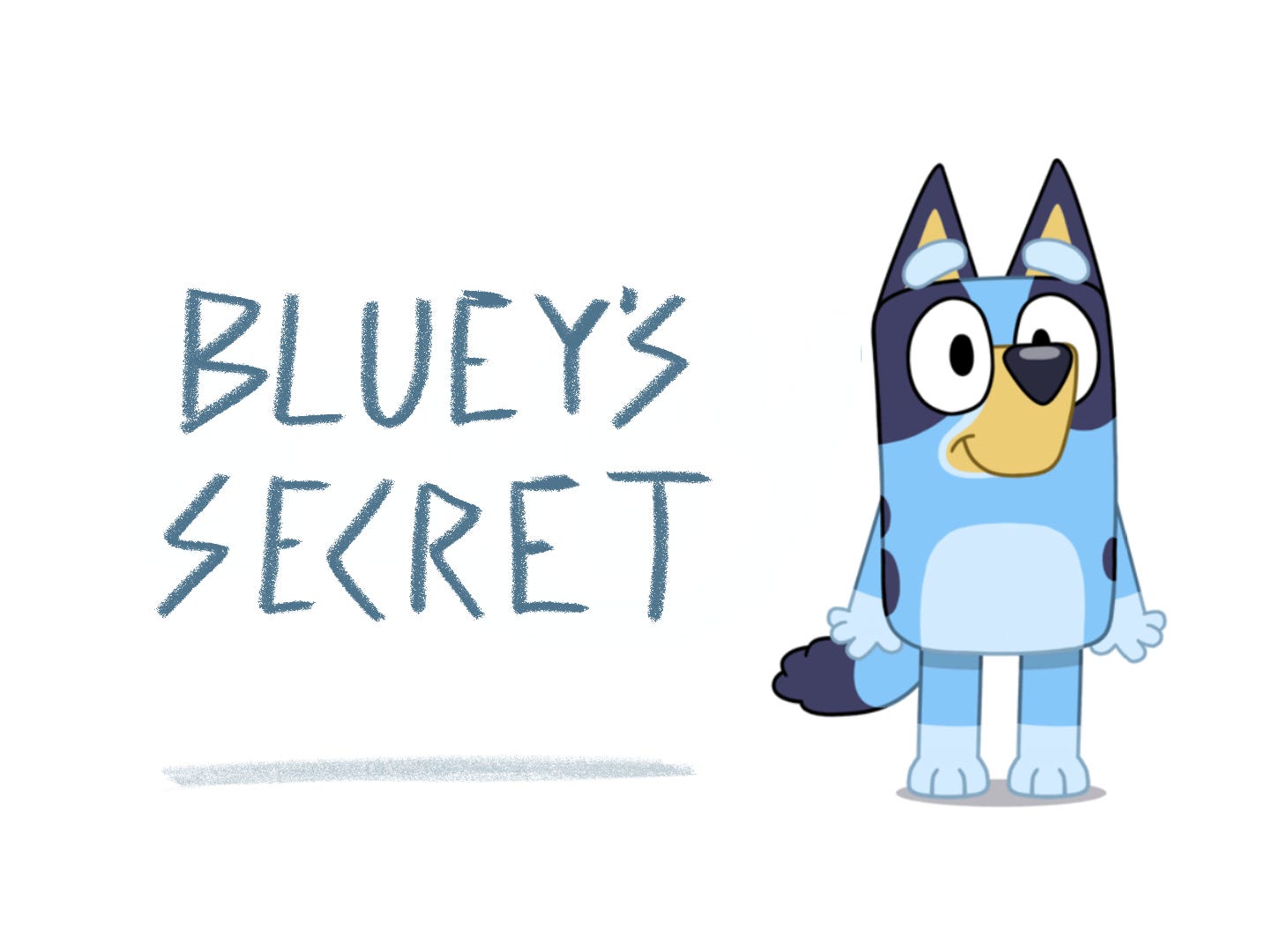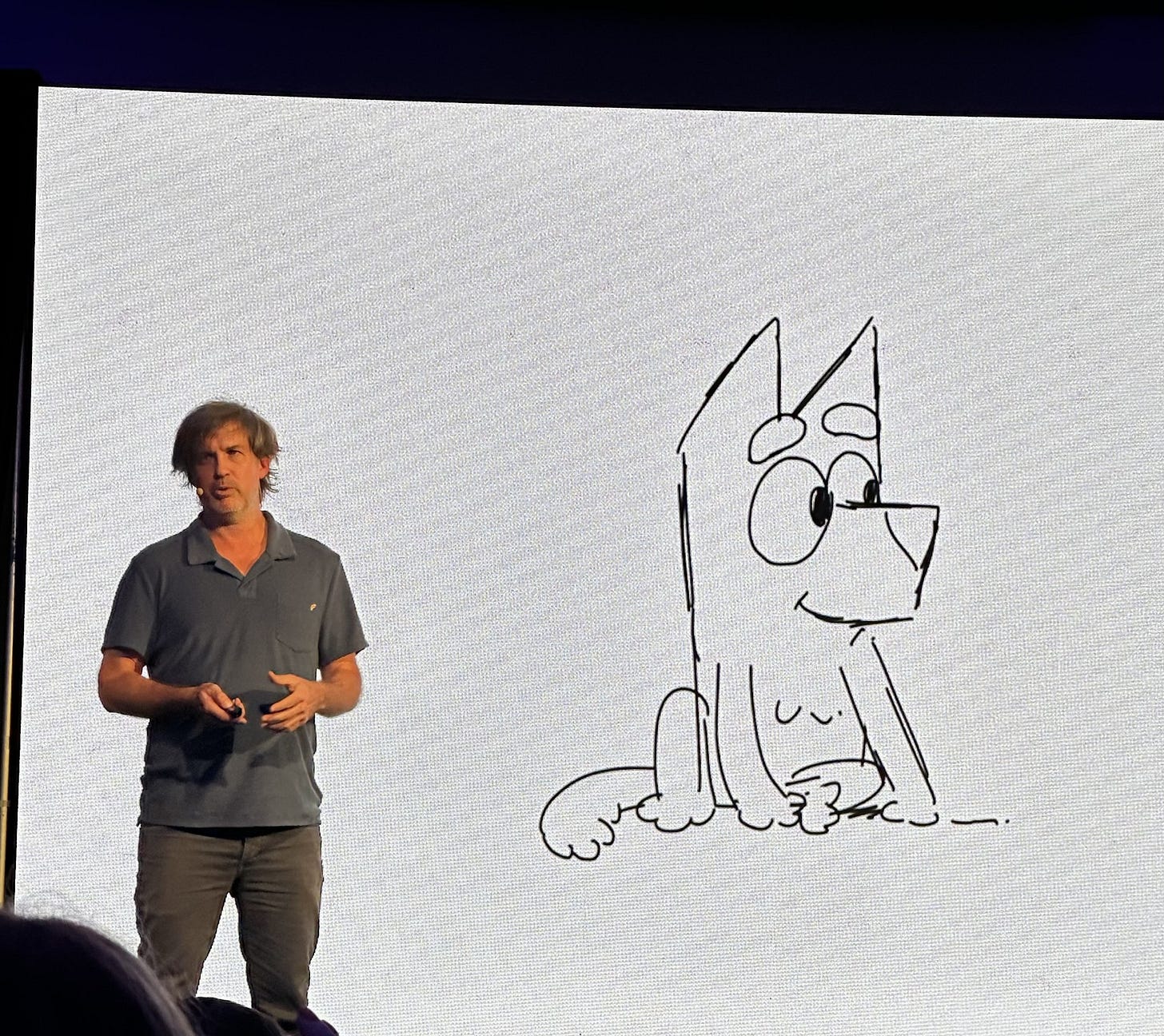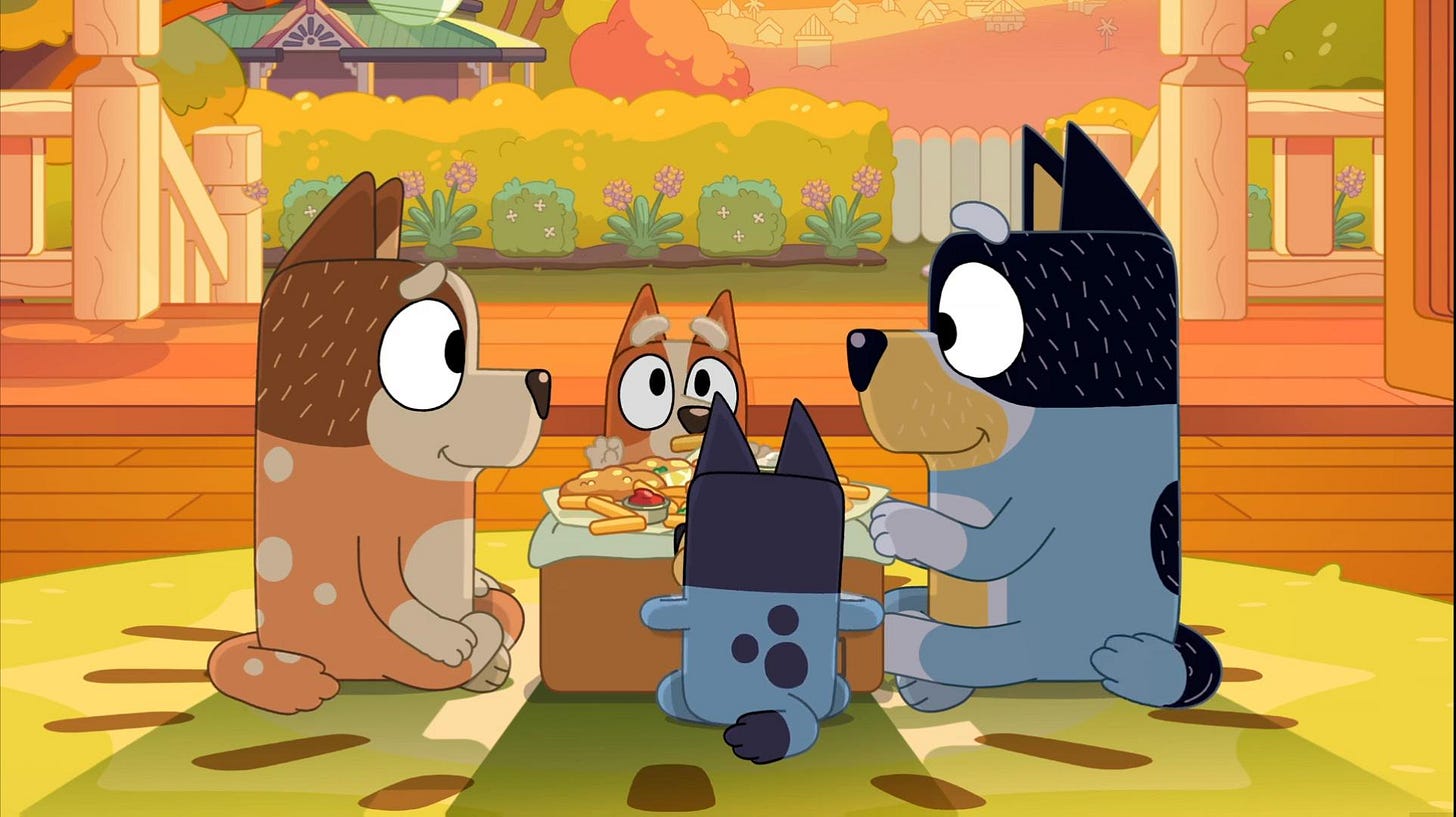Bluey’s Secret: Why a Kids’ Show is the Most Watched TV Series of 2025
What Bluey’s Cross-Generational Appeal Reveals About Attention, Trust, and Designing for Shared Joy
Attention
When it comes to the modern economy, pundits tend to agree on at least one thing: attention is the new currency—or, at least—that attention is one of the most essential and effective drivers of capital. Visibility is closely linked to profitability, and while there will always be brands that benefit from anonymity and playing background, there is little doubt that most companies benefit when in positions of notoriety and public influence.
If this is true, business professionals should be studying the mass movements of attention just as much as they do to the movement of stocks, prediction markets, and geopolitics. Indeed, attentional literacy is swiftly becoming one of the most defining skills of successful executives, politicians, and cultural innovators, which is why today’s dispatch is a breakdown of one of the most popular stories in modern culture. And while this story is having an outsized influence on future generations, here’s the kicker:
Unless you are the parent of young children, you might not even be aware that this show exists.
The Show
According to Nielson’s streaming charts, the most watched show of the first two quarters of 2025 was not Friends, Grey’s Anatomy, NCIS, Squid Game, White Lotus, or even Severance. Rather, the singularly most watched show of 2025 from January to June was the Australian-based cartoon Bluey—an animated series that follows a six-year-old Blue Heeler puppy, her little sister Bingo, and their parents Bandit and Chilli.
The show has amassed over 25 billion viewing minutes in just six months. That’s over 2.85 million years— just a little longer than our specific genus of human has even been on the planet. Although most shows in the top-watched category can run for thirty minutes to an hour, Bluey episodes rarely run for more than seven minutes, the licenses of which were purchased by Disney and now appear on their streaming platform. A full-length feature film is set to release in 2026 and Disney is rumored to be exploring various ways to incorporate the IP into theme parks.
While this cartoon has obviously mastered the art of capturing eyeball share, it is widely applauded for doing so without dipping into the common strategies of modern digital media. Bluey contains no action, no rage bait, no wild plots, no villains, no noisy gags, no slapstick comedy. Instead, Bluey is grounded in the emotional and familial drama that children encounter in real life, often broaching difficult topics in an elegant way. Topics like bullying, divorce, infertility, neurodiversity, social comparison, or learning how to play without friends.
Trust
The truth is— Bluey doesn’t just capture attention. It earns attention. When I asked some parents whether or not they let their children watch Bluey (they did) and why they like it, here was a response I received:
“Kids like it because its a fun show with imagination and funny dog sisters having fun and making inside jokes. Besides the above, I like it because it's vetted and wholesome and I know it won’t cause potential issues like [redacted show] which has body shaming and rudeness.”
The bottom line is ‘trust,’ and that’s a value that the creator of Bluey, Joe Brumm, pursued from the beginning for one simple reason—he wanted his own children to be able to watch the show. In fact, Brumm has repeatedly emphasized that his own children are the inspiration for the characters and situations depicted in each episode:
“Usually they’re related to something I’ve learned having kids, or my wife has experienced or just something I notice that my kids keep doing. An episode really wouldn’t start until I’d found a bit of truth like that… That’s why kids and adults see themselves reflected in it. You love your children to death and they change you completely.”
Knowing that Brumm’s familiarity with the target demographic is from firsthand experience and that his product is built first and foremost for his family is a vital insight. So much success really does boil down to experience, knowing your customer, and solving the things that matter most to them. Brumm’s skin in the game has acted as a true north for the Bluey project and has effectively preserved the beloved show from mission drift for several years.
Brumm’s integrity in this arena has become undeniable, especially after he published a letter in December 2024 explaining that he was going to be stepping away from the TV series:
“I always said I wouldn’t keep making the show if I thought I couldn’t make any new season as good as the last. This would have been the case for me with a potential season four, so I’ve decided to take a break from my involvement in the TV series… To walk away from it while it’s at such a height will seem crazy to some but, for now, I am finding it difficult to reach back genuinely into that four to six year old world and write authentically.”
While not every decision-maker in a company has the advantage of being a real-life user of their own product like Brumm, he was also wise enough to know that this was the source of his competitive advantage. Necessity is the mother of invention and more innovation would take place if companies were more versed in studying the needs of their consumers and being as dedicated as Brumm has been to providing value. When a creator or brand begins to rely on gimmicks, planned obsolescence, dark patterns, or other undesirable tactics, it is a sure sign that they have become disconnected from the needs of their base.
Storytelling
Although fresh and revitalized, Bluey is not necessarily the first children’s show to take a narrative, gentle approach to their programming. In many ways, it can be seen as a spiritual successor to a Bob Ross or—most especially— Mr. Rogers. The latter, whose hit show Mr. Roger’s Neighborhood debuted nationwide in 1968 and aired for more than three decades, also seemed to defy the common wisdom regarding attention spans by eschewing the violent or spectacular ‘bombardment’ of other shows in order to adopt a simple, story-telling approach.
In fact, in 1969, Mr. Rogers went to Washington DC when a proposal to cut $10 million of funding for educational non-profit broadcasting was being considered (that’s about $89 million in today’s money). In order to communicate the importance of his and his colleague’s work, he explains his approach as follows:
“I'm very much concerned, as I know you are, about what's being delivered to our children in this country. I've worked in the field of child development for six years now trying to understand the inner needs of children. We deal with such things as the inner drama of childhood. We don't have to bop somebody over the head to make drama on the screen…. We deal with such things as getting a haircut, or the feelings about brothers and sisters and the kind of anger that arises in simple family situations — and we speak to it constructively.
More wit and one song later, Mr. Rogers was able to convince the notoriously hard-nosed Senator to award the full amount, which saved the newly formed Corporation for Public Broadcasting and paved the path for the development of PBS and NPR. For brands and companies, the lesson here is quite simple: story beats spectacle.
The concept of storytelling is not new to modern workplaces, but rage-bait, viral antics, and AI-generated slop remain all too common as instruments of attention-seeking. Firms that double down on elegant, simple storytelling have the opportunity to set themselves apart by sending out meaningful signals rather than noisy splash. When compared to other shows on Disney+ like Spiderman, Clone Wars, or Phineas and Ferb, then Bluey certainly might seem to lack flash and sizzle; but there is no question regarding who is capturing the most eyeballs.
Whether its six year olds or Senators, people are evolved to process, remember, and feel through stories, which makes narrative competence one of the most important abilities. Jyoti Guptara, author of Business Storytelling, puts it this way:
Versatile storytelling will save you time for the rest of your life as people receive, believe and remember your message… Mastering storytelling can make you more successful, but perhaps more importantly, it will help you reconnect your life and business with your humanity and make you happier.
And many, many others have emphasized the importance of storytelling in the contemporary era. Although syndicated television shows are inherently formatted in a narrativistic manner, one of the most advantageous activities for modern professionals is to sharpen this ancient and time-tested ability.
Double-Layered Marketplaces
The interplay of these factors results in what I believe is the real “secret sauce” of Bluey: a sustained, shared, and inter-demographic experience.
You read earlier that parents enjoy the show almost as much as children—and this is a key element in its success. Bluey operates in what I call a ‘double-layered’ marketplace, where approval for the product needs to be sustained by more than one party in order to remain viable. In any media space, parents can put on a show for their children to watch, but the children have the power to reject it if they find it distasteful. Similarly, children can love a specific show, but the parents can reject it if they find it inappropriate or annoying. This is not entirely indifferent from a dynamic we see in a number of other industries where the buyer is a distinctly different party than the end user.
B2B SaaS companies, for instance, have the trifficult job of creating a product that needs to work effectively for everyday workers, but also needs to ‘wow’ the upper managers and promise certain results. Educational material or corporate training curricula also exist in double-layered marketplaces because they are again created primarily for a user who is not necessarily the buyer, and needs to fulfill a function for one while simultaneously appeasing the other. Other looser examples might include dog food, insurance, and *wipes brow sheepishly* lingerie.
The key to winning in a double-layered marketplace is to create a shared experience for all demographics involved, which begins with identifying each layer, respecting their veto ability, and designing the product to be a unifying force between both layers. Bluey isn’t just a show that parents turn on and leave their kids to watch; but also a sit-down event for whole families to learn and enjoy together. Scenarios depicted in the show become examples that parents use to remind their kids of good behavior, while games that the animated children play become real life adventures for parents and kids to imitate during playtime. By enabling whole families to participate, reflect, and play together, the show is transformed from passive viewing into active connection-making.
Even a family’s language, one of the most powerful building blocks of culture, can be heavily influenced by Bluey. Scholars have made studies of the use of "invitational language” in the show, and some of the bespoke words from the show become common vernacular in any given household. An example is the word “trifficult”— a trademarked portmanteau of the words “tricky” and “difficult”– which I dropped into the first sentence of a paragraph above. Did you catch it?
Conclusion
The true genius of Bluey, and why it’s the first subject of Mercury’s Playbook, is not just in its storytelling, but in its quiet revolution against the media status quo—a subtle rebellion built on dignity, empathy, and creativity. In a world obsessed with spectacle and in an industry all too willing to pollute the mental health of children for profit, Bluey reminds us that transformative impact springs from intentional creativity, shared play, and imaginative design. It challenges us to rethink not just what we create, but pushes the limits on who can benefit from our innovations and how to maximize value across multiple spheres of participation. By conquering a double-layered marketplace, where value is produced through co-experience, mutual respect, and consistency, Bluey models a way forward for innovators: to make things that bind people together, encourage autonomy, and foster tender radicalism with lasting impact.
Feathers For The Footnotes (Bonus Links)
About the Author
Bradley Andrews is a hopeful rabble-rouser on a mission to inspire the world. Stay in touch with what he’s doing outside of Mercury’s Playbook by subscribing to a weekly digest of his activity through micro.blog. This will send you writing, photos, and other curiosities that extend beyond the scope of this newsletter.





